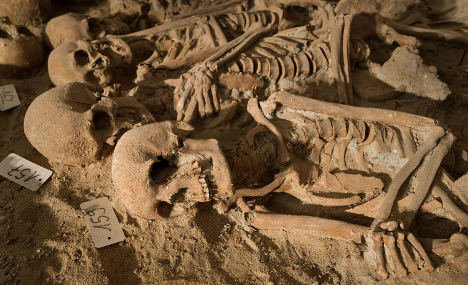Paris – More than 200 skeletons have been discovered in a medieval mass grave beneath a supermarket in the middle of the French capital, with archeologists unsure of how they died or why the bodies were placed there.
Mystery of mass grave of 200 skeletons found beneath Paris supermarket by workmen http://t.co/Sq4MB3dRLK pic.twitter.com/NZUR3ByFv4
— The Mirror (@DailyMirror) March 3, 2015
The site was once the cemetery of a hospital that operated from the 12th to the 17th century, but it had previously been thought the corpses from the hospital and its cemetery had been moved in the 18th century to the Paris Catacombs, which are home to the bones of six million people transferred from the city’s cemeteries 200 years ago.
The Monoprix supermarket called in archaeologists to inspect the site before building work began.
According to the Daily Telegraph, Pascal Roy, the director of the supermarket on Boulevard Sébastopol, said: “We thought that there would be a few bones as it was the site of a cemetery but we didn’t think we would find a communal grave.”
https://www.youtube.com/watch?v=RD1hFQtZJIk
The paper adds that the archaeologists from the French National Institute of Preventive Archaelogogical Research (INRAP) plan to carry out DNA tests to discover the cause of death, which they believe could be the plague.
INRAP has released a statement about the find, writing: “Monoprix Reaumur Sebastopol occupies the old building Félix Potin, built on the site of the cemetery of Trinity Hospital, founded in the twelfth century and destroyed in the late eighteenth century.
“The excavation of graves will help better understand the funerary practices implemented in hospitals in medieval and modern eras. It offers the opportunity to observe particularly the management of the dead by the living in mortality crises (epidemics, fever, famine).”
Eight multiple graves have so far been discovered. Seven of them have between five and twenty individuals, filed in two to five levels.
INRAP adds: “The eighth hole is much more important with, for now, more than 150 dead. They were deposited carefully and show a very organised deposit method: at least two rows of individuals are filed “head to tail”, a third row seeming to grow beyond the limits of the excavation. The bodies are based on five to six levels.
“This very large mass grave whose boundaries are not identified, appears to correspond to a mortality crisis whose cause is currently unknown. Adults (women and men of all ages) and children are represented. The skeletal remains do not show damage (diseases, injuries) to identify the cause of the mass death. DNA samples are underway to determine it. Radiocarbon dating will also be conducted to understand the chronology of these multiple burials.”
Agencies/Canadajournal
 Canada Journal – News of the World Articles and videos to bring you the biggest Canadian news stories from across the country every day
Canada Journal – News of the World Articles and videos to bring you the biggest Canadian news stories from across the country every day



